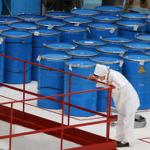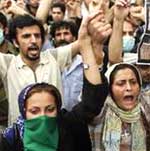Iran to Start Building Long-Range Missiles
The report said that Iran tested the Shihab-3 in the Semman region last month. Iran now plans to produce at least 150 of the missiles, which are capable of dropping a one-ton warhead on Israel, the report said.
Until now, the Iranians are known to have conducted only three test launches, two of which failed and one that was a questionable success.
According to the Turkish report, Iran is also preparing to test its 2,000-km Shihab-4 soon. Israeli officials estimate Iran has so far been able to amass an arsenal of at least 20 Shihab-3s, which are based on a North Korean design for the No Dong medium-range rocket with Russian improvements. Turkey is particularly concerned since its major cities are within the range of Iranian missiles.
The Turkish intelligence report warned that Turkey needed to take countermeasures and that Turkey and Israel are the primary targets for the Shihab-3 should a conflict erupt.
Yiftah Shapir, editor of the Jaffee Center for Strategic Studies' Middle East Military Balance and an expert on missiles, questioned the validity of the Turkish report.
However, he said it is quite feasible that Iran would start production of the missile.
"It is a major step. I wouldn't be surprised if they have come to this point. It first surfaced six years ago and this would be enough time to end the development stage and start production," Shapir said.
He added that production could also mean making two or three missiles a year, not mass production. He said that even if the development isn't complete, the Iranians could introduce modifications during and even after production. Nevertheless, he said Israelis have no reason to be more concerned about an Iranian threat today than they were yesterday.
"We knew the capability was there and this was coming. But we believe that the missiles are meant as a deterrent. You don't have to expect a missile falling on our heads tomorrow morning. States don't do that," he said.
According to Shapir, Iran has enemies other than Israel, like Iraq and central Asian and Gulf states.
"When you look at the world from Teheran, it looks like a very menacing place. Ideologically, Israel is the little Satan, but practically, we are not on their list of real enemies," Shapir said.
According to the Turkish intelligence report, Iran has already procured a sophisticated air defense system based on the Russian S-300 missile. It has sent a number of technicians to Moscow for training. Intelligence reports say Iran is currently operating at least 10 laboratories working on chemical and biological weapons.
Iran has a robust missile industry and currently has some 500 missiles in its arsenal. These include 195 300-km Scud-Bs, 150 500-km Scud-Cs, 25 150-km CSS-8s, and 25 200-km Musshaks.
Additionally, Iran has developed its Zulfikar tank, making some changes with its armor and fire capability. Iran is to produce 300 Zulfikars a year, with 125-mm cannon and night vision, as it continues to produce 400 T-72 tanks with Russia. It is also developing a new armored personnel carrier at its main military production base at Kolehduz.
* ANICA is the Armenian National Information Center of America is a non-profit, non-political, non-religious educational, historical, cultural, scientific, and charitable organization and also serves as a news service and information exchange.
This article can also be read at: http://www.jpost.com/NASApp/cs/ContentServer?pagename=JPost/A/JPArticle/Full&cid=1021378903163







